content

The ever-multiplying online content gives rise to a need to look for alternative methods of capturing users’ attention. Creators have to come up with a stream of new ideas and figure out a way to add more to the basically endless production of content which, at first, draws people in for a minute, and later on becomes irrelevant and superseded by more and more publications. Evergreen content operates on a different set of rules.
Evergreen – timeless freshness
To visualise the speed at which content is being published on the Internet, all we need is some statistics – about 250,000 websites are created worldwide every day (Huss 2022), while 7.5 million posts are published on blogs (Wise 2022). The rapid creation of content means, among other things, that the bulk of it loses its popularity very quickly.
According to Google, stale documents are those “no longer updated, diminished in importance, superseded by another document” (Acharya et al. 2008). The opposite of stale texts would be those that are “timeless” – such is the case of evergreen content, also known as “search-optimised content that is continually relevant and stays ‘fresh’ for readers over a long period of time” (Digital Marketing Institute 2021). Its role is to continually attract users and generate website traffic.
To illustrate the difference between stale and evergreen content, we will rely on Google Trends – a website that analyses the popularity of top search queries in Google Search. The graph below shows the sudden interest in the phrase “Will Smith hit”. It concerns the incident that occurred on March 27, 2022, during the Academy Awards gala. Will Smith, annoyed by host Chris Rock’s jokes, slapped the comedian:
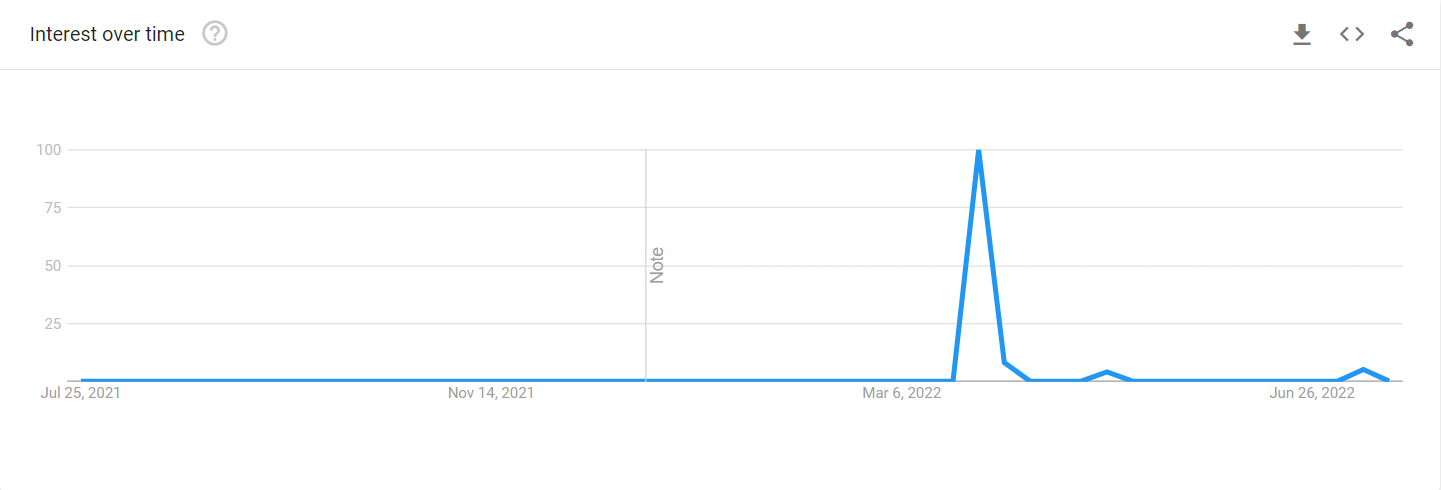
Source: Google Trends
The interest in the event reached its peak on March 27, then it dropped (despite brief spikes in the following weeks, as more people and more celebrities kept sharing their opinion on the matter on social media), and then it finally died. Of course, news outlets tried to outrival each other in attracting as many visitors as possible by offering full coverage of the scandal:
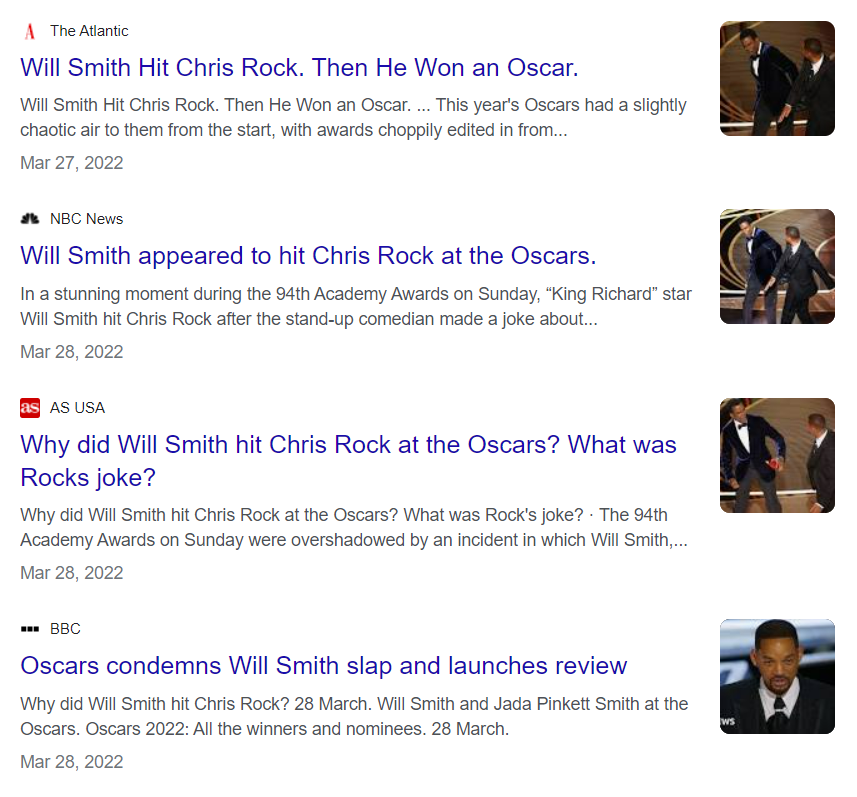
Source: Google
By mid-April, those articles could already be considered stale content. Something else managed to catch the attention of Internet users.
We will get vastly different results if we type “how to lose weight” into Google Search:
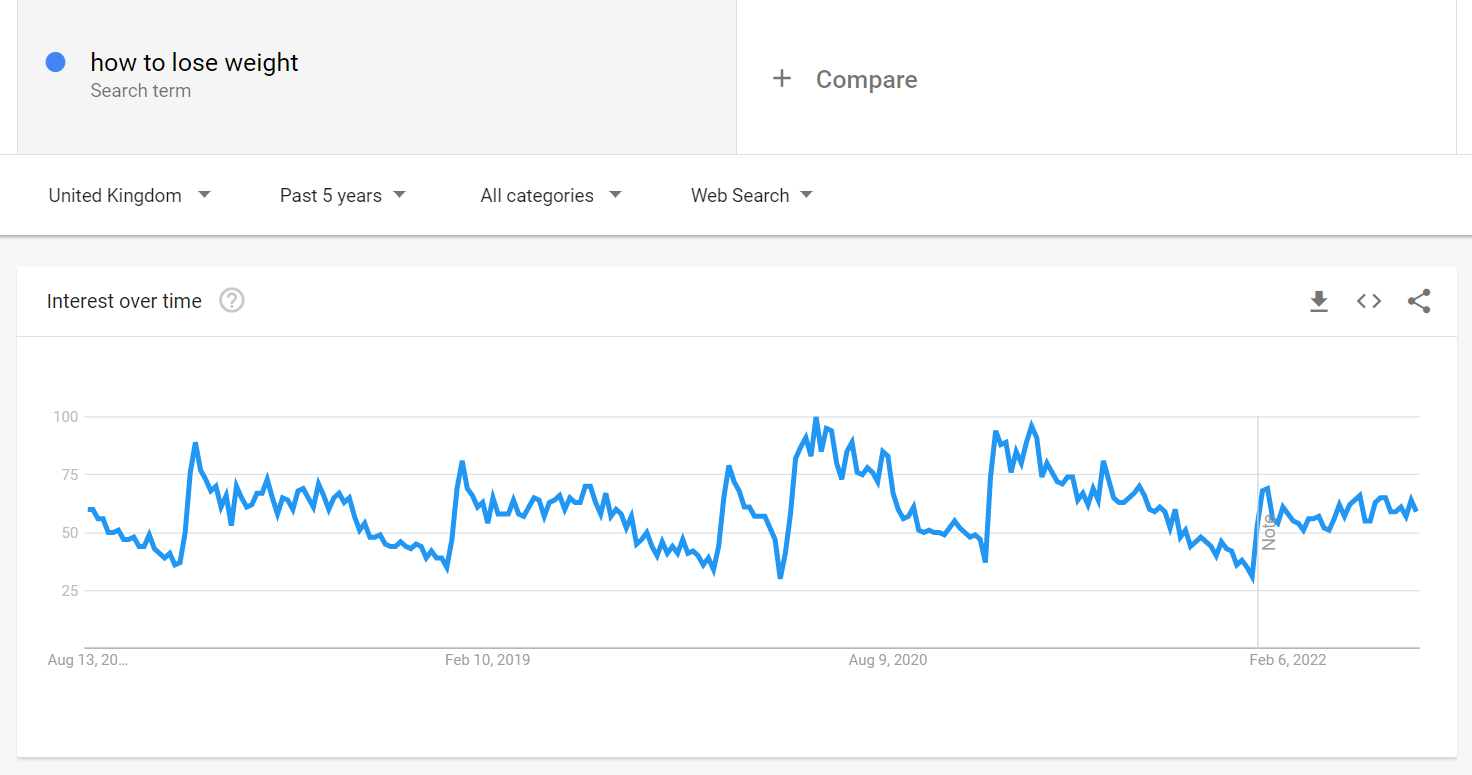
Source: Google Trends
There have always been and always will be people who want to shed a few kilograms, scouring the web to find an effective solution (or a cure-all) to their burning problem. The interest in the phrase is subject to fluctuation, which is especially evident at the beginning of each year – so full of hope and solid resolutions (“This time, it’s for real”) – but even in the laziest moments of autumn and winter (“Before Christmas, there’s no point in starting”), it usually does not fall below 30% of the maximum value.
In this particular case, you will need a weight loss-related text to create evergreen content, preferably presented as a detailed guide: “How to… [do something (for example, lose weight)]”. If you include information about dietary products or personal trainer services in your text, you get a website that has not only attractive content, but also a huge sales potential. It’s a win-win!
There’s even more good news – evergreen content doesn’t have to be created with only individual users in mind. It’s also extremely appealing to companies looking for new ways to generate revenue all the more effectively. In their case, guides could also do great numbers; however, they should concern more professional topics – for example, ways to increase sales on e-commerce websites.

Source: Nethansa / https://nethansa.com/blog/how-to-increase-sales-on-amazon
Types of evergreen content
Though guides seem to be the go-to strategy when it comes to creating evergreen content, other (just as compelling!) formats include:
- listicles (articles that are lists),
- tips and universal information,
- case studies,
- stories behind a given phenomenon,
- product reviews,
- videos.
It should be noted, however, that the last two bullet points work only in certain cases.
List for days
A hundred books you MUST read… Harry Potter films ranked from worst to best… List of the rarest zodiac signs… Ever since Sir John Lubbock, 1st Baron Avebury, listed a hundred books worth reading during his speech in 1886, all kinds of lists and rankings have become extremely popular tools used to spark interest. In the digital age, the listicle is one of the most commonly used (according to critics – too commonly) means of conveying information and engaging the audience. Such publications are described as “concise content with predictable structure which a lot of people eagerly interact with” (Okrent 2014).
Reader’s Digest put together a list that is both attractive and profitable. The article on the magazine’s website concerns 100 best books ever written, and the author confidently notes that “[i]f you want to fill your shelves with the best books of all time, you’re in the right place” (Beabout 2022). Each one of the 100 must-reads is annotated with a brief comment under which there is a convenient “Shop Now” button leading directly to the Amazon library. Thus, every potential reader automatically becomes a potential buyer (whose money will also go to Reader’s Digest; the author of the article makes it clear in the introduction that the periodical receives an affiliate commission from the sale of the linked books).
The book descriptions also include attention-grabbing links that lead to other articles related to a given topic (for example, science fiction books), which automatically improves the website’s positioning in search engines. The list will continue to attract both bookworms and casual readers, and its timelessness could not be more evident – after all, the article specifies the best books of all time and not, for example, last year’s bestsellers.
Speaking of Amazon – Jeff Bezos’s online store also makes use of the list format, but in a slightly different way. Each Amazon user has access to several different lists focused on specific trends (e.g., bestsellers, most popular gifts, highest-rated books) and special recommendations based on previously viewed or bought items.
Those lists could also be considered “evergreen”, even though they are not created by brilliant copywriters, but by algorithms that are constantly processing huge amounts of information. The raw data, however, needs to be processed, categorised and studied. At the end of the day, someone has to decide what interests the customer most and what could be used to create a specific list. The best-selling products on Amazon are simply begging to be presented as a list – and that is exactly why the Amazon Sales Ranks are so popular.

Source: Beabout 2022.
Starved for information
Apart from step-by-step guides that thoroughly explain how to do or achieve something, users are also constantly seeking information, advice, and tips. According to Ahrefs, Merriam-Webster is the most-visited online dictionary in the world, with over 120,000,000 monthly visitors looking up words, idioms and grammar rules (Hardwick 2022). People also seek out information that concerns products they are interested in buying.
Everyone who loves online shopping knows what a nuisance it is to order something on the Internet, wait a few days for the package to arrive, and then eagerly try the thing on, only to find out it is the wrong size. If we ask Google “how to choose the correct shoe size”, the first non-featured result will lead us to a blog post of a Lithuanian shoe brand – Dolita Shoes. Carefully chosen keywords and keyphrases have boosted the website’s traffic and positioning, making it appear on the first page of Google Search results for our shoe query. The article contains useful tips for choosing the right shoe size when shopping online, as well as two detailed footwear size charts for men and women. The online store has clearly taken advantage of the visitor boost – as we scroll down, the very top of the website is constantly reminding us that Dolita is having a sale. And since we are only one click away from the brand’s rich catalogue, we might as well take a look at whatever the store has to offer, no?

Source: Dolita / https://www.dolitashoes.com/blogs/news/how-to-choose-the-correct-shoe-size-when-shopping-online
Case study
Customers or potential clients looking for a particular service provider may want to know what the process they are interested in looks like from the inside out. How do companies operating in a given industry deal with difficulties and how do they successfully overcome those obstacles? It is an excellent excuse to both shine a light on your brand and impress a prospective client with your expertise. Besides, as pointed out by e-commerce specialist Aaron Orendorff, it is an excellent opportunity to tell a story – “and everybody loves a good story” (Orendorff 2016).
For example, the locatheart translation agency shares valuable industry tips on their blog. Articles such as “Agile translation: how we manage 175+ new translation orders a day for a single client” (Wąsowska 2022) or “Certified translation – should you, when, and how?” (Lewalska 2021) not only constitute a testament to professionalism and experience, but also serve as a guideline for those who are looking for a language service provider that handles certified translations (and there is always someone looking for such an agency) or agile translations. Both case studies end with a call to action that is somewhat suggestive (but not in an in-your-face way) and that encourages the visitor to contact the company to talk about individual forms of assistance and cooperation.

Source: locatheart / https://locatheart.com/agile-translation-ten-square-games-case-study
A taste of timelessness
To create evergreen content, one might also make use of a certain phenomenon; however, the materials must be unique enough to continually be piquing people’s interest and attracting those hungry for knowledge.
One of Americans’ favourite dishes – the famous mac‘n’cheese – will serve as a delicious example. How did all of the United States fall in love with that culinary treat in the first place? A brief history of the phenomenon can be found on the Smithsonian Magazine website (it also pops up as one of the first results when googling “mac and cheese history”). But what is particularly interesting is that the same topic has been covered in two articles – one from 2018 and the other from 2011. It is pretty simple – based on the popularity of the first text, the magazine decided to write another one. The original version, however, has not been removed, as it continues to improve the page’s positioning in Google Search results. As we all know, appetite comes with eating, and consuming a visually appealing and accessible article might earn the magazine another subscriber.
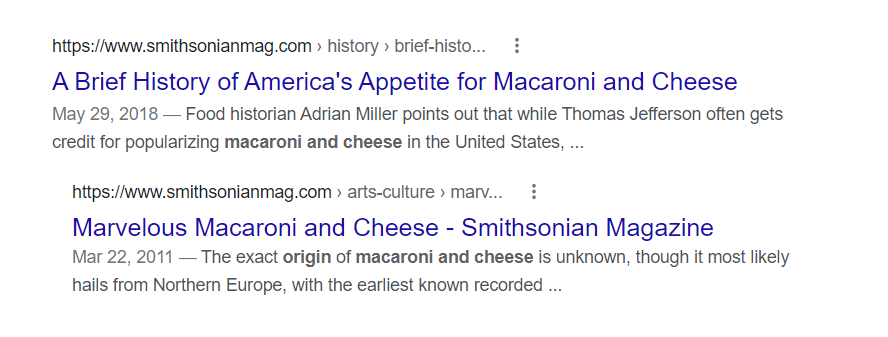
Source: Google
Culinary trivia may also do wonders for other websites. The story behind the popularity of mac‘n’cheese seems like the perfect material to feature on a blog of a food brand or a restaurant whose menu is graced by the presence of the delicious dish. The first eatery whose website covers the topic of the origins of the cheesy treat (and appears on the second page of Google Search results) is Felix’s BBQ with Soul – a restaurant that specialises in Southern soul food. Once again, everyone who visits the site is prompted to order food from Felix himself, though the conversion, of course, will only be successful if the visitor is currently in California.

Source: Google
Tell me about…
Reviews and videos can also work as evergreen content, but not always. In order to continually attract people from a specific target group, they have to concern ever-relevant topics. An ordinary review of yet another ordinary phone, which differs from its predecessor only in serial number, will disappear into the depths of the World Wide Web almost as soon as it appeared.
A different fate, however, awaits a memorable review whose attractive form and continued relevance will keep reaching more and more people who will keep the content promoted by a given platform’s ranking algorithm. If we type “PS4 review” into the YouTube search bar, the first thing to pop up will be an IGN review published almost nine years ago, which still continues to generate views.

The incredibly long life cycle of the video game console is certainly crucial here. PlayStation 4 was released in 2013 and to this day, it remains insanely popular among gamers who had to wait seven years for its successor, PlayStation 5. In fact, when PS5 came out, people actually looked up the older console’s review.

Source: YouTube
Fireworks of today
Not all content has the potential to become evergreen. Sometimes, it is due to its type, and other times – to many different and unrelated factors (e.g., a failed technological or economic forecast). Below, we provide examples of topics that may have left a mark on the digital world, but whose potential to attract audiences has diminished over time. Although such content often presents itself as evergreen, ultimately, that is not the case.
Fifteen minutes of fame
What can Whisper do for your business? Well, it is hard to tell, as finding a detailed introduction to Whisper is not an easy task. Wait, an introduction to what? Exactly.
Whisper is a secret-sharing social network that, according to press reports from nearly a decade ago, was expected to beat Facebook and Twitter in terms of popularity (Ostruszka 2014). In 2013, it generated 3 billion page views per month, and today… it still exists, but does not even make the list of the top 100 social media apps (in 2020, it ranked 122nd in the iPhone app store [Harwell 2020]). The risk of trying to create evergreen content, of course, is that ultimately, it might not stand the test of time and simply become a one-month wonder.
A list of very, very specific things
While an article entitled “BEST HORROR FILMS OF ALL TIME” sounds like a textbook case of evergreen content, “What’s Coming to Netflix in May 2020” is the total opposite of that. The second text concerns a very specific moment in time – May, 2020. While it probably generated extremely high traffic at the beginning of that month, it is very unlikely that anyone revisited the article in, let’s say, December (unless, of course, they wanted to compare the titles added to the streaming service). Still, the author of the article was well aware of the algorithms. The May text had served its purpose and, a month later, its successor came to life and let everyone know what was coming to Netflix in June, 2020.


Source: Ahrefs
Article with the latest pop culture sensation in the title
When a particular film, TV series or video game is on everyone’s lips, it is hard to resist the temptation of taking advantage of its popularity and redirecting the attention of its die-hard fans towards your content.
A British e-commerce agency, Fluid Commerce, did just that by publishing an article entitled “Jon Snow Might Be Dead (We Hope Not), But SEO Isn’t! Here’s Why…” (Fluid Commerce 2015) on their blog. You might ask, “Why did it seem like a good idea at the time?” References to the thrilling finale of the fifth season of Game of Thrones placed the content within a specific time frame and were all about making a quick profit. It is no surprise that the farther we move from that point, the lower the website traffic (not to mention that the last season of the series disappointed a great deal of fans and negatively affected the reception of the entire production). Unfortunately, as the graph below shows, using popular keywords goes hand in hand with having huge competition, and such a move does not always bring the desired results:

You still know nothing, John Snow…
Nokia 1100
There are very few products that are truly timeless (such as the Chanel No. 5 perfume). Yesterday’s phenomenon may be overshadowed by whatever is coming today; it is also possible that a brand that once ruled a given industry will become a mere shadow of itself in the years to come. The early 2000s had Nokia phones breaking various sales records – every device produced by the Finnish brand could count on an incredibly detailed review, providing the website that published it with an insane amount of web traffic. However, over time, the company lost its strong industry position and had to give way to its competition. This means that the Internet is full of old (and now pretty irrelevant) reviews that once kept attracting mobile phone users for years, today serving as trivia regarding this century’s best-selling device. Classic GSM phones have been superseded by their “smarter” cousins and since that moment, everything has changed. The lifespan of a smartphone is usually shorter than that of a regular cell phone; devices are regularly replaced by their newer versions to guarantee trouble-free use of the latest apps or games and comfortable consumption of Internet content. For this reason, smartphone reviews are unlikely to make for evergreen content.
Web traffic generators
While some content will be attention-grabbing only for a short while (what a stinging slap!), it is possible to pick out topics that have the potential to become a strong textual or audiovisual foundation, acting as a web visitor magnet – if we properly make use of them, of course. Here are some examples which are always up-to-date.
For private consumers:
“5 ways to wear a little black dress” – this popular piece of clothing is a must-have for most women. But how and when should they wear it? Those questions have been spinning through many female minds since the 1920s, when Gabrielle “Coco” Chanel popularised the dress. Simplicity, elegance and a wide range of possibilities when it comes to, for example, the choice of accessories have contributed to making this piece a staple of women’s wardrobes – as well as a popular online query.
“How to tie a tie?” – many generations have struggled with taming this classic accessory. There are people who are lucky enough to be able to ask a family member for help; however, that does not mean that people are not looking for how-to articles regarding the topic. Be it a business meeting, a friend’s wedding or a candle-lit dinner – there will always be someone who is willing to learn the ins and outs of the art of tying a tie (and, if a given site contains direct product links, perhaps also to purchase a new one).

Source: Google Trends
“How to remove a stain?” – from a tie, a little black dress, your beloved T-shirt or a couch. Due to Murphy’s law or a tearing hurry, your favourite piece of clothing or furniture could be tainted by a stain. An ugly, greasy, stubborn one. If not immediately taken care of, it could dry up and ruin something forever. Regardless of how it came to be, even at this very moment, someone is valiantly fighting to get rid of it. The first search result when googling the phrase “how to remove a stain” is a stain removal guide – fresh as ever.
For companies and entrepreneurs:
“Starting a business” – even Bill Gates and Elon Musk had to start somewhere. The goal is pretty clear – to conquer the market, go to space, and then buy out Disney. Still, before you get to refer to your garage as the birthplace of your genius business idea, you need to complete the necessary paperwork and take the appropriate steps to even get started. Businesswomen, innovators, future Silicon Valley hot shots – they all want to find out how to take the first steps on the road to success. Addressing their concerns could make for great evergreen content.
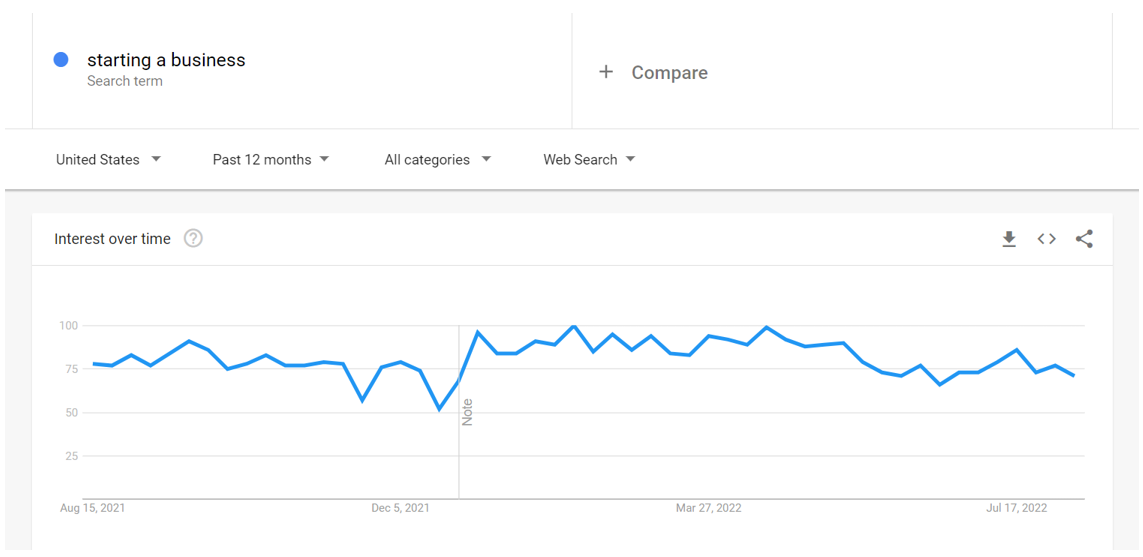
Source: Google Trends
“SEO and content marketing strategy” – for a company to succeed, it must exist on the Internet. However, it is not enough to set up a website or an e-store. Today, it is all about great content marketing and well-positioned websites. If you want to beat the competition in the battle for the top search results, you need to make an effort. Regardless of the type of business someone runs, in the 21st century, any forward-thinking entrepreneur will seek information on the key elements of online marketing. On the first page of Google results, there is an article from October, 2015, which covers this subject. E-commerce is still a hot topic and the industry will only keep flourishing. There is no need to worry about this type of content going stale.
“What is localisation?” – every successful company that wants to conquer foreign markets and become a global player will need to localise product names and descriptions, marketing strategies and content for other languages, cultures and contexts. Given the rapid growth of the e-commerce industry, this topic will also guarantee several years of freshness, if covered extensively.
Always up-to-date (but updated)
Although the phrase “evergreen content” itself suggests something of continued relevance, such content should not be treated as a one-and-done process where you publish something and never go back to it. You should always revisit your evergreen content – preferably on a regular basis, for example, once a month or once a quarter – carefully review it and check whether it continues to fulfil its function, namely drawing in a steady stream of new users, readers and potential buyers. The list of 100 best books of all time is subject to change – what if you need to mix things up a bit because an absolute masterpiece has recently been published? Special attention should be paid to outdated information that may mislead the reader. If an article on how to lose 5 kilograms of excess weight praises a discredited diet that turned out to be a dud, we risk losing people’s trust.
The opposite also may happen – when an article that was not considered evergreen becomes such content, due to, for example, continued popularity of a given topic.
One way to keep your content fresh is to remove the time context from the link, while leaving it in the title of the article. Imagine an article on a hypothetical website www.greatreviews.com: “Best films on Netflix – May 2022”. In that case, search engines will think that the words in the web address refer to the very best films on the streaming platform, and the article itself will refer to a particular month of the year. If the text is updated each month, it will fulfil its marketing function, guaranteeing fresh content for pop culture enthusiasts. Articles related to New Year’s Eve (and the constantly changing aspects of the event, which you need to know all about if you want to be up-to-date with the current trends) are also updated annually.
When it comes to running a website, you will get the best results from laying a solid foundation of evergreen content which can be complemented by hot topic articles meant to capture people’s attention only for a bit. If your resources do not allow for such a large-scale effort, evergreen content should be the backbone of your site – in the long run, steady growth will always win over a temporary trend (sorry, Will Smith).

Given the ever-changing world and market conditions, evergreen content seems to be an excellent tool for building up your brand and attracting new customers. Although the attention of online users and consumers may shift to something else in a flash, it is worth focusing on topics that are assumed to stay more relevant than the latest article about celebrity drama. Creating great content that will either link to certain products or directly appear in a marketplace is the key to achieving notable success in the e-commerce industry – after all, potential readers may become potential customers. If you are not sure where to start, it is best to have industry experts create such content for you. Reach out to us if you have any questions regarding the matter!
Sources
Acharyja, A. et al. (2008), Information Retrieval Based on Historical Data, 18.03, Google Patents, https://patents.google.com/patent/US7346839B2/en, retrieved on 10.05.2022.
Beabout, L. (2022), 100 Best Books of All Time, 28.01, Reader’s Digest, https://www.rd.com/list/books-read-before-die/, retrieved on 10.05.2022.
Digital Marketing Institute (2021), The Beginner’s Guide to Evergreen Content, https://digitalmarketinginstitute.com/blog/the-beginners-guide-to-evergreen-content, retrieved on 10.05.2022.
Fluid Commerce (2015), Jon Snow Might Be Dead (We Hope Not), But SEO Isn’t! Here’s Why…, https://www.fluidcommerce.co.uk/blog/jon-snow-might-be-dead-we-hope-not-but-seo-isnt-heres-why/653/, retrieved on 10.05.2022.
Harwell, D. (2020), Secret-Sharing App Whisper Left Users’ Locations, Fetishes Exposed on the Web, The Washington Post, https://www.washingtonpost.com/technology/2020/03/10/secret-sharing-app-whisper-left-users-locations-fetishes-exposed-web/, retrieved on 10.05.2022.
Huss, N. (2022), How Many Websites Are There in the World?, Sitefy, /https://locatheart.com/certified-translation-should-you-when-and-how/, retrieved on 10.05.2022.
Lewalska, M. (2021), “Certified translation – should you, when, and how?” , LocAtHeart – Blog, https://locatheart.com/pl/tlumaczenia-przysiegle-dla-kogo-kiedy-i-jak/, dostęp: 10.05.2022.
Okrent, A. (2014), The Listicle as Literary Form, „Uchicago Magazine”, Vol. 114, No. 2, https://mag.uchicago.edu/arts-humanities/listicle-literary-form, dostęp: 10.05.2022.
Orendorff A. (2016), 20 Types of Evergreen Content that Produce Lasting Results for Your Business,https://copyblogger.com/evergreen-content/, retrieved on 10.05.2022.
Ostruszka, Ł. (2014), Whisper – serwis, który pokona Facebooka i Twittera?, Polityka, https://www.polityka.pl/tygodnikpolityka/ludzieistyle/1588751,1,whisper–serwis-ktory-pokona-facebooka-i-twittera.read, retrieved on 10.05.2022.
Wąsowska, A. (2022), /span>“Agile translation: how we manage 175+ new translation orders a day for a single client”, LocAtHeart – Blog, , retrieved on 10.05.2022.
Wise J. (2022), How Many Blogs Posts Are Published Per Day in 2022? [Latest Statistics], Earthweb, https://earthweb.com/how-many-blogs-posts-are-published-per-day/, dostęp: 10.05.2022.


